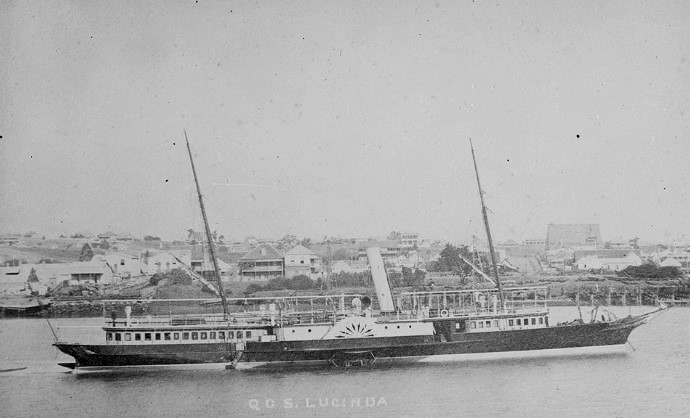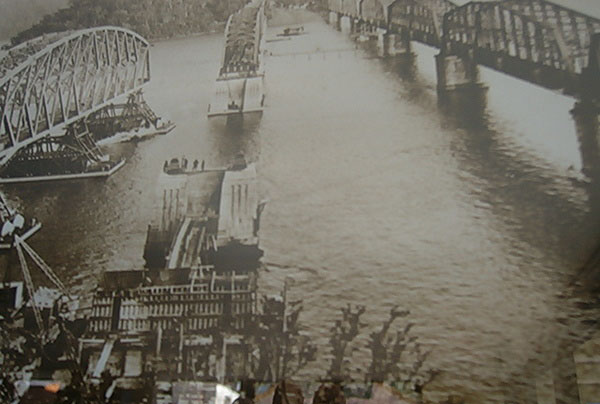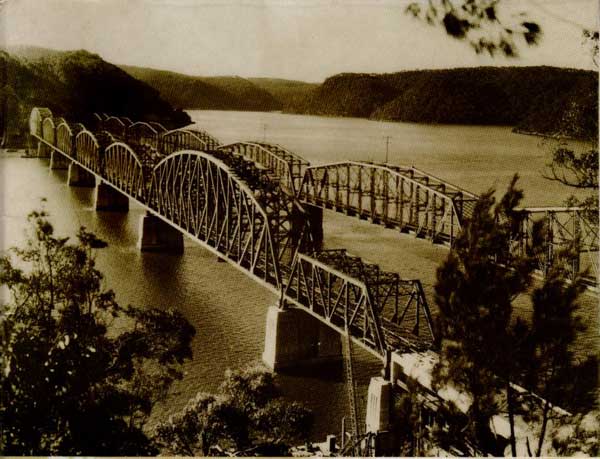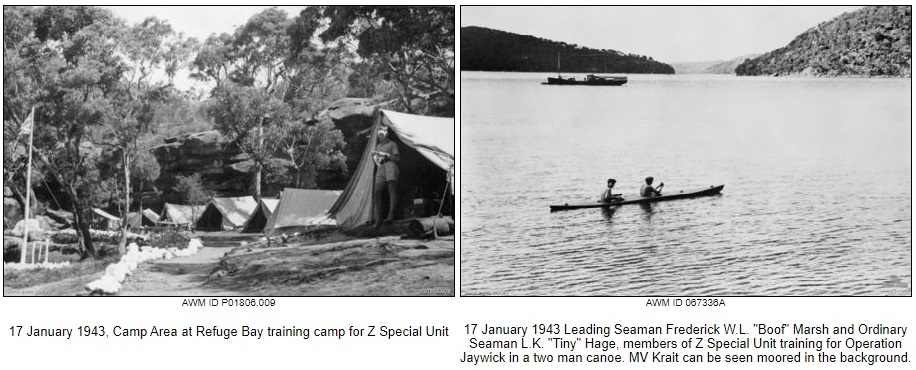|

The Hawkesbury River is steeped in Australian History.
Australia's Constitution.
An extraordinary event occurred at Refuge Bay on the Hawkesbury River in late
March 1891. Government leaders from Australia's colonies gathered in Sydney for the
constitutional convention. They spent the Easter cruising the Hawkesbury River
on the Queensland paddle steamer 'Lucinda', showering under a pristine waterfall
at Refuge Bay in Ku-ring-gai National Park with the news papers reporting - 'the only time politicians came clean in
public'.
Leaders present included Charles
Kingston, Sir Edmund Barton, A.J.Thynne, Sir John Downer, Henry Wrixon and
Bernhard Wise.
The Steam Ship Lucinda was 172ft
long 25ft wide with a 9ft draft run on a 2 cylinder 114 nominal
horse power steam engine powering 12ft dia. paddle wheels.

Naming The River. In
March 1788, Governor Arthur Phillip set off to find more suitable land for
agriculture and travelled up the Hawkesbury River as far as Dangar Island. He
returned the following year and navigated the river to a point upstream of
Windsor. He gave the river its modern name to honour Charles Jenkinson, First
Earl of Liverpool, England and the Baron of Hawkesbury. The Aboriginal name for
the Hawkesbury River is 'Deerubbun'.
Royal Visits. Brooklyn
also played host to the Duke & Duchess of York, later King George V and
Queen Mary, while cruising the river on the paddle-steamer 'General Gordon'.
They were invited to Australia to open Federal Parliament in 1901.
An impressive
avenue of palms that today line the entry to McKell Park were planted to commemorate the visit
of the Prince of Wales (later the Duke of Windsor) who came to
Brooklyn for a picnic on the 24th of June 1920.
The Rail Bridges. The
first Hawkesbury River railway bridge was constructed by the Union Bridge
Company of Brooklyn, New York and opened with the first train crossing in May
1889. The bridge enabled trains for the first time to travel some 2,880
kilometres from Australia's top to bottom albeit with two breaks of gauge on the
Victorian and Queensland borders.
"Australia United", celebrated the newspaper
headlines. A special banquet was held for guests on a large pontoon off Dangar
Island. The guest list included Sir Henry Parkes who acclaimed the bridge as a
major stimulus to federation.
A major achievement of its time as one of the piers reached a
depth of 162 feet before resting on solid rock, it was the deepest structure in
the world. It took two years to build but in 1937 cracks appeared in some of the
piers. Heavy traffic during WWII further weakened the structure and it became
unsafe.
The new bridge was opened in 1946 with each of its piers
containing fresh water tubes that are periodically tested for salt water
contamination.


During WWII the bridge was protected from Japanese attack by
anchoring boom nets from Dangar Island especially after maps salvaged from the
midget submarines that raided Sydney in 1942, showed targets marked around the
bridge.
Ship Wrecks. Australia's
first military gunboat lies in Cascade Gully near Milson's Passage on the Lower
Hawkesbury River. The HMAS Parramatta was just 70 meters (245ft) long, weighing
700 tonnes and capable of 29 knots but in her day she was regarded as a
destroyer armed with just one four inch gun and three torpedo tubes. Built in
Glasgow in 1910, she served in New Guinea, the Mediterranean and the Black Sea
during World War 1 and ended her service career in 1928. In 1930, together with
HMAS Swan, she was towed from Sydney to Cowan Creek to provide accommodation for
prisoners who were to construct a road to Appletree Bay but the plan never
eventuated. After being sold in 1933, both ships were used as carriers for
construction material from Brooklyn to Milson and Peat Islands. The Swan sank in
1934 and in 1935 a wild storm caused the Parramatta to break free of her mooring
and she ran a ground under the towering cliffs of Cascade Gully. For several
years she provided shelter for unemployed men and was used to store water from a
nearby water fall for the use of the river residents. In 1973, the Naval
Historical Society removed the bow and stern of the ship for memorials at Garden
Island and Parramatta but her heart and sole still lie on the salty banks of the
Hawkesbury River.
Refuge and America Bays.
From September 1942 till February 1943- Refuge Bay was the top-secret training base for the Z Force when
preparing for their daring raid on Singapore harbour. The vessel used for this
assignment was a 20m. ex-Japanese fishing boat, the ' Krait ' which is now in
the National Maritime Museum.

Dangar Island . Captain
Phillip's exploration party landed on Dangar Island on the 7th of March 1788.
They caught a quantity of fish and so named it Mullet Island. In the early days
some boat building took place and salt was produced for shipment to Sydney. The
island was acquired in 1864 by Henry Dangar and renamed. The first white child
born there was James Stanbury who became the world sculling champion in 1891,
1892 and 1896. Stanbury was a very big man renowned for his strength who would
row to a point 15klm. upriver from Dangar Island known now as Big Jims Point
where he built his home.
Wisemans Ferry. The
original road to link Sydney to the Hunter passed over the Hawkesbury at Wisemans Ferry. Part of this
remains and on the northern side of the Hawkesbury across from Wisemans Ferry
one of the most remarkable and important engineering feats is preserved in the
Dharug
National Park
. This section of the
Great North Road
is known as Divines Hill and the massive stone walls and ramparts are a must
for all visitors to the area. One
Soloman Wiseman obtained the contract to feed the convicts and gave his name to
the ferry that crosses the
Hawkesbury
River
, free of charge, every day of the year.
Windsor.
Governor Phillip and his party reached this area by boat on 6th July 1789 and
named it Green Hills. He was impressed with its farming potential and quickly
arranged for food production to begin in order to relieve the shortages in Port
Jackson. Governor Macquarie named the settlement Windsor in 1810. Convict
architect Francis Greenway designed the Courthouse, built in 1822 and the
impressive St Matthews Anglican Church, built in1820.
Bar Island.
Because of its central location to the surrounding small communities, St John's
Church was built in 1876 to be used as a church and community meeting site as
well as a school, it was used until 1887.
The church ceased to be used in about
1892, when the one at Brooklyn was built. It deteriorated and was finally
demolished in 1906, apart from the Vestry chimney. A burial ground contains
nearly sixty graves, mostly unmarked, with the last burial in 1906. On the western end of the Island stands a memorial to two
Outward Bound instructors drowned in the Murray River who's ashes were scattered
on the Island
Mooney Mooney Creek.
Mooney Mooney Creek bridge is the highest road bridge in the southern hemisphere
spanning 480mtrs. in three sections ( 130m, 220m, 130m ) and stands 75mtrs. from
the high water mark. It was opened in December 1988.

|